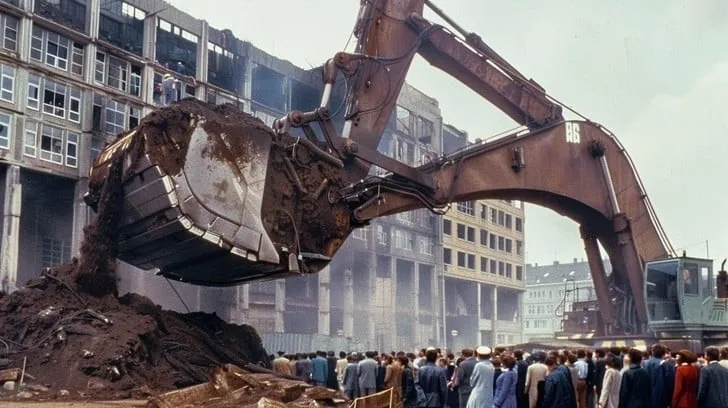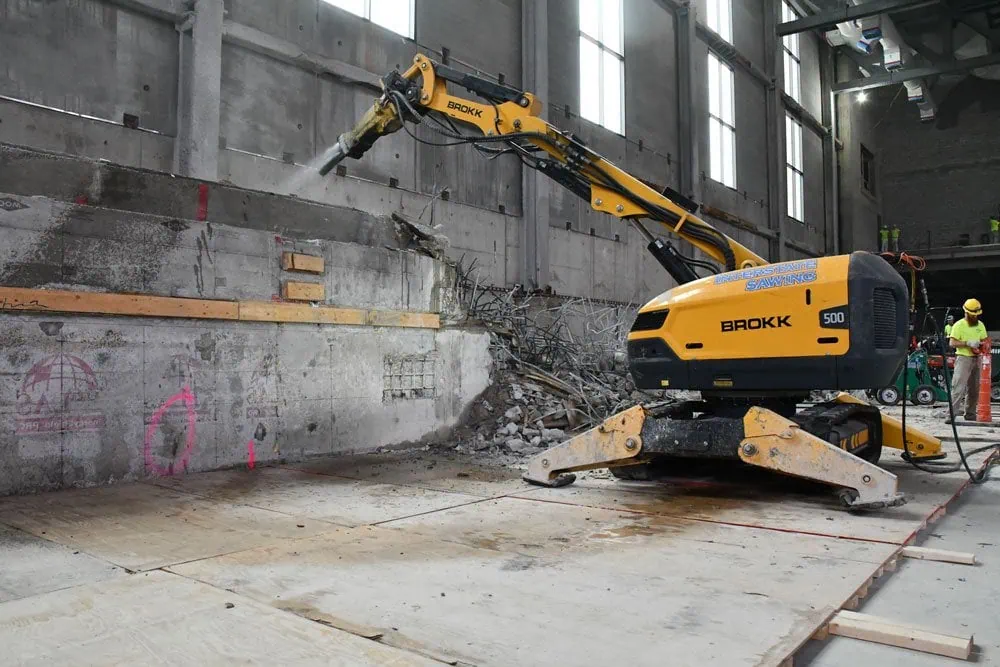When tackling a demolition project, selecting the right machinery is key to ensuring the job is done safely, efficiently, and on time. With so many types of demolition equipment available, how do you know which one is best for your needs? In this comprehensive guide, we’ll cover the different types of demolition machinery, their specific uses, and tips on how to choose the right equipment for your project.
Table of Contents
ToggleWhat Is Demolition Machinery?
Demolition machinery refers to a range of heavy-duty equipment designed specifically for the task of tearing down buildings, and structures, and clearing debris. These machines are built to handle tough tasks in demolition work, from breaking down concrete and steel to lifting and hauling debris. The type of machinery needed varies depending on the scale of the project and the materials involved.
Key Functions Of Demolition Machinery
Breaking Down Structures: The primary function of demolition equipment is to safely and efficiently bring down buildings and structures.
Clearing Debris: After the demolition, these machines help clear rubble, waste, and materials from the site, preparing it for further construction or redevelopment.
Heavy Lifting and Transporting: Demolition equipment, such as excavators and cranes, can lift and move heavy debris, making cleanup more manageable.

What Equipment Is Needed For Demolition?
The type of demolition equipment you need depends on the size and scope of the project. Below are some of the most commonly used pieces of machinery:
Excavators
Excavators are crucial in breaking down concrete, steel, and other materials. They can also be used for site clearing and hauling debris.
Bulldozers
Bulldozers are often used for larger-scale site clearing, pushing debris and leveling ground in preparation for further demolition.
Cranes
Cranes are essential for demolishing taller structures, especially high-rise buildings. They often carry tools like wrecking balls or hydraulic shears to bring down large structures.
Hydraulic Shears
These powerful tools are used to cut through steel, concrete, and other tough materials. Hydraulic shears are often used for more precise demolition tasks.
Wrecking Balls
One of the most iconic demolition tools, wrecking balls are used for bringing down large, multi-story structures by swinging into them with great force.
Crushers
Crushers are used to break down debris after demolition, turning concrete, asphalt, and other materials into smaller pieces that can be reused or disposed of efficiently.
Skid Steer Loaders
For smaller residential demolition projects, skid steer loaders are ideal. These compact machines are also useful for site preparation and cleanup.
Types Of Demolition Machinery
Different demolition jobs require different types of machinery. Here are some of the most commonly used machines in the industry:
Excavators
Excavators are among the most versatile demolition machines, equipped with attachments such as hydraulic hammers, shears, and grapples to handle a variety of tasks. They can demolish buildings, clear debris, and even lift heavy materials.
Applications in Demolition:
Breaking Concrete and Walls: Excavators fitted with hydraulic hammers are used to break down concrete and walls.
Site Clearing: They are also employed to clear rubble and debris after the demolition process is completed.
Bulldozers
Bulldozers are typically used for clearing large areas of land and pushing debris around. With their large blades, they help prepare the site for further demolition or construction work.
Applications in Demolition:
Clearing Site Debris: Bulldozers are ideal for moving large piles of rubble and clearing the land for new construction.
Site Preparation: Before demolition begins, bulldozers can clear smaller buildings and level the land.
Crushers
Crushers are used to reduce large chunks of concrete, stone, and other materials into smaller, manageable pieces. These machines are key for recycling demolition waste and making materials ready for reuse.
Applications in Demolition:
Recycling Materials: Crushers break down debris such as concrete and brick into smaller pieces that can be used again in construction projects.
Waste Disposal: Crushers help in efficiently managing waste by turning large materials into more manageable sizes.
Wrecking Balls
Wrecking balls, attached to cranes, are a traditional method of demolition. These heavy steel balls swing into buildings to knock them down, especially in large-scale demolitions of high-rise buildings.
Applications in Demolition:
Demolishing High-Rise Buildings: Wrecking balls are used to bring down tall structures in a controlled manner.
Tearing Down Concrete Walls: Wrecking balls can effectively break through reinforced concrete walls.
Hydraulic Shears and Attachments
Hydraulic shears are attachments for excavators that are used to cut through tough materials such as steel beams, concrete walls, and metal structures. These tools are ideal for more selective, precise demolition tasks.
Applications in Demolition:
Cutting Steel Structures: Hydraulic shears are commonly used to dismantle steel beams and columns during industrial demolitions.
Selective Demolition: This method is useful when only parts of a building need to be taken down while preserving other sections.
What Are The Three Methods Of Demolition?
Demolition can be accomplished using various methods, depending on the project’s scope, the materials involved, and safety requirements. The three primary methods of demolition are:
Mechanical Demolition
Mechanical demolition is the most common method, involving the use of large machines such as excavators, bulldozers, and cranes. These machines are equipped with powerful attachments that help break down structures quickly and efficiently.
Advantages:
Fast and effective for large-scale demolitions.
Less labor-intensive compared to manual methods.
Implosion
Implosion is a method that uses explosives to collapse a building in on itself. This technique is typically used for large, multi-story buildings where other methods may be too slow or unsafe.
Advantages:
Extremely fast, often completing the demolition in mere seconds.
Ideal for urban areas where surrounding buildings must be protected.
Deconstruction (Selective Demolition)
Deconstruction, or selective demolition, involves carefully dismantling a building piece by piece. This method is often used to preserve reusable materials like wood, metal, and brick, making it an environmentally friendly option.
Advantages:
Environmentally conscious, allowing for the recycling and reuse of materials.
Perfect for historic buildings or projects that require selective dismantling.
Applications Of Demolition Machinery
Demolition machinery plays a crucial role across a variety of industries. The type of demolition equipment used depends on the specific requirements of the project. Below are some of the most common applications:
Residential Demolition
Residential demolition projects involve tearing down houses or smaller buildings to make way for new construction. Smaller machinery like mini-excavators, skid steer loaders, and bulldozers are commonly used for these types of projects.
Applications:
Clearing Old Homes: Demolition machinery is used to bring down old houses, preparing the site for new construction.
Site Preparation: Machinery also helps clear debris and level the land for future projects.
Industrial Demolition
Industrial demolitions involve large-scale structures like factories, warehouses, and plants. Larger, more powerful machinery such as hydraulic excavators, wrecking balls, and crushers are typically used.
Applications:
Tearing Down Factories: Heavy machinery is used to dismantle large, complex industrial buildings made from steel and reinforced concrete.
Recycling Materials: Crushers are employed to recycle concrete and steel, reducing waste and increasing sustainability.
Bridge and Road Demolition
When demolishing bridges, highways, or roads, demolition equipment like cranes, bulldozers, and excavators come into play. These machines break down the old structures and clear the land for new development.
Applications:
Bridge Demolition: Cranes and excavators are often used to dismantle and remove bridges.
Road Removal: Bulldozers and graders clear old roads, preparing the land for new construction.
Commercial and High-Rise Demolition
For large commercial buildings and high-rise structures, powerful demolition machinery like wrecking balls, high-reach excavators, and cranes are necessary. These machines bring down tall buildings in urban environments with minimal disruption to the surrounding area.
Applications:
High-Rise Demolition: Wrecking balls or hydraulic excavators with long arms are used to demolish skyscrapers and multi-story buildings.
Selective Demolition: Demolition equipment is used to carefully dismantle parts of the structure while preserving others.

How To Choose The Right Demolition Machinery For Your Project
Assess the Project Size and Scope
Larger demolition projects require larger equipment. For smaller residential demolitions, mini-excavators and compact bulldozers may suffice. For larger, industrial-scale demolitions, you’ll need bigger, more powerful machinery.
Consider the Terrain and Location
The location of the project is crucial. Urban demolitions may require compact machinery to navigate tight spaces, while rural projects may allow for larger machines with more power.
Choose Based on the Material Type
Different materials require different equipment. For example, hydraulic shears are ideal for dismantling steel, while crushers are best for breaking down concrete and rubble.
Budget and Costs
Demolition machinery can be expensive, so it’s essential to evaluate your budget. Renting equipment may be more cost effective for smaller projects, while larger projects may justify purchasing machinery.
Conclusion
Demolition machinery is essential for safely and efficiently executing demolition projects. With a variety of machines available, including excavators, bulldozers, wrecking balls, and crushers, it’s important to choose the right equipment based on your project’s size, materials, and complexity. By selecting the appropriate machinery, you ensure that your demolition project is completed on time, on budget, and with minimal environmental impact.
